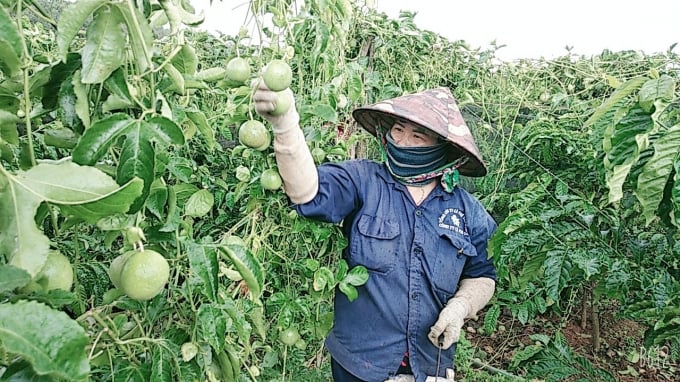November 28, 2025 | 00:24 GMT +7
November 28, 2025 | 00:24 GMT +7
Hotline: 0913.378.918
November 28, 2025 | 00:24 GMT +7
Hotline: 0913.378.918
Concerned about human resource development in rural areas, Dr. Le Quan, Director of Vietnam National University - Hanoi, has spent many years studying the current situation, achievements and limitations in vocational training for rural workers. Dr. Le Quan drew on his experience thanks to lessons from Japan, South Korea, India, China, and Thailand, thereby setting out a system of views, tasks and solutions for these issues.

Dr. Le Quan, Director of Vietnam National University - Hanoi.
I.
According to the 2020 Labor and Employment Survey Report of the General Statistics Office, the labor force in rural areas is approximately 36.7 million people, accounting for nearly 67% of the national labor force. This continues to put pressure on the need for training and resolving on-site employment for rural workers.
Rural labor migration causes a shortage of jobs in urban areas and at the same time a shortage of labor in rural areas. The unemployment rate of migrants in 2020 is about 9.82%, 4.4 times higher than the general unemployment rate of workers aged 15 and over (2.25%). The unemployed workers are mostly those without professional and technical training.
The percentage of trained workers with primary or higher degrees in rural areas is only 16%, much lower than in urban areas (39.3%). Improving rural labor quality is a big challenge.
The training scale in agriculture in training institutions is constantly in decline. On the other hand, workers who have received training, especially highly trained workers, do not want to go back to the countryside.

The percentage of trained workers with primary or higher degrees in rural areas is much lower than in urban areas.
This situation comes from the objective fact that the countryside does not have enough material and technical foundations to employ highly skilled workers. Meanwhile, income from the agricultural sector is still low, agro-products price is always in a state of devaluation despite good harvest while the costs of agricultural materials and services are expensive.
Moreover, the application of advanced and smart technology in agriculture remains difficult. The State's investment in agriculture, countryside and farmers is still too small, leading to ineffective human resource training for rural areas, yet meeting the requirements of modern agriculture development and new rural construction.
II.
Countries around the world have synchronously implemented many different human resource development solutions. Vietnam can refer to some of them to resolve the issues concerning rural labor and employment:
Firstly, develop a strategy for rural human resource development, creating a foundation to implement policies with the goal of promoting human resource development in the direction set by the State.
The rural training strategy will help farmers attain a strong belief in themselves upon facing physical and mental difficulties so that they can become more active, dynamic and creative.
The government must be the major investor, the most comprehensive in the construction of vocational training institutions. Businesses are responsible for listing out their employment needs and plans and participating in the training process.
Secondly, diversify professional training activities to effectively transfer professional knowledge and skills to rural workers according to the development needs of economic sectors.
Thirdly, promote the industry in rural areas, create conditions to further develop rural human resources.
Apart from developing non-agricultural economy in the countryside, strengthening vocational training and renewing land policies, Japan pays special attention to rural industrial development. They have policies, plans and master plans to promote industry in big cities and later the countryside. Thailand also offers a lot of preferential policies for businesses to invest in rural areas.
Since the late 60s of the twentieth century, South Korea has implemented many solutions to promote industrial development in rural areas. In 1968 they promulgated the "Local Industrial Development Act" which emphasized promoting the development of industry in urban areas to rural areas.
Fourthly, pay attention to vocational training for the second generation of migrant workers.
In the case of China, this is a matter of sustainable human development. Because agricultural labor mobility is closely related to labor migration.
Migrant workers from rural to urban areas are necessary for economic growth, but reality shows that this group is always disadvantaged in many policies particularly in terms of human resource training and nurturing. These individuals need to receive training to integrate into the urban society, get a job, and participate in the labor market with high productivity and efficiency.
Translated by Samuel Pham

(VAN) After the institutional merger, Da Nang possesses significant forest-carbon reserves and is proactively engaging in the carbon market, creating a new revenue stream.

(VAN) An Giang strengthens communication against IUU fishing, increases inspections and sanctions, and is determined to remove the EC’s “yellow card” while developing a sustainable fisheries sector.

(VAN) As green transition becomes a global trajectory, Viet Nam’s biggest challenge is not only technology and models, but how to ensure that capital flows reach the right beneficiaries.

(VAN) The Ministry of Agriculture and Environment must spearhead the construction of green governance, spanning decision-making processes and investment standards to policy evaluation mechanisms.

(VAN) The Agriculture and Environment sector of Khanh Hoa has achieved numerous milestones over the past 80 years, contributing significantly to the goal of establishing the province as a centrally governed city by 2030.

(VAN) Viet Nam is entering the pivotal period of 2025-2030, moving toward the formulation of the Remote Sensing Law, which will establish a legal foundation for the development of national digital data.

(VAN) The agricultural sector is finalizing the strategic framework for emission reduction, setting the goal of sharply cutting methane and 403.7 million tons of CO2 equivalent and moving toward Net Zero by 2050.